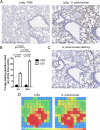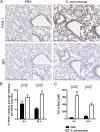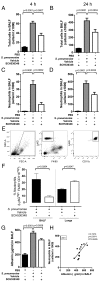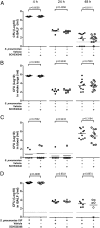Regulation of neutrophilic inflammation by proteinase-activated receptor 1 during bacterial pulmonary infection
- PMID: 25948816
- PMCID: PMC4456635
- DOI: 10.4049/jimmunol.1500124
Regulation of neutrophilic inflammation by proteinase-activated receptor 1 during bacterial pulmonary infection
Abstract
Neutrophils are key effector cells of the innate immune response to pathogenic bacteria, but excessive neutrophilic inflammation can be associated with bystander tissue damage. The mechanisms responsible for neutrophil recruitment to the lungs during bacterial pneumonia are poorly defined. In this study, we focus on the potential role of the major high-affinity thrombin receptor, proteinase-activated receptor 1 (PAR-1), during the development of pneumonia to the common lung pathogen Streptococcus pneumoniae. Our studies demonstrate that neutrophils were indispensable for controlling S. pneumoniae outgrowth but contributed to alveolar barrier disruption. We further report that intra-alveolar coagulation (bronchoalveolar lavage fluid thrombin-antithrombin complex levels) and PAR-1 immunostaining were increased in this model of bacterial lung infection. Functional studies using the most clinically advanced PAR-1 antagonist, SCH530348, revealed a key contribution for PAR-1 signaling in influencing neutrophil recruitment to lung airspaces in response to both an invasive and noninvasive strain of S. pneumoniae (D39 and EF3030) but that PAR-1 antagonism did not impair the ability of the host to control bacterial outgrowth. PAR-1 antagonist treatment significantly decreased pulmonary levels of IL-1β, CXCL1, CCL2, and CCL7 and attenuated alveolar leak. Ab neutralization studies further demonstrated a nonredundant role for IL-1β, CXCL1, and CCL7 in mediating neutrophil recruitment in response to S. pneumoniae infection. Taken together, these data demonstrate a key role for PAR-1 during S. pneumoniae lung infection that is mediated, at least in part, by influencing multiple downstream inflammatory mediators.
Copyright © 2015 The Authors.
Figures







Similar articles
-
Proteinase-activated receptor-1, CCL2, and CCL7 regulate acute neutrophilic lung inflammation.Am J Respir Cell Mol Biol. 2014 Jan;50(1):144-57. doi: 10.1165/rcmb.2013-0142OC. Am J Respir Cell Mol Biol. 2014. PMID: 23972264 Free PMC article.
-
Regulation of neutrophilic inflammation in lung injury induced by community-acquired pneumonia.Lancet. 2015 Feb 26;385 Suppl 1:S52. doi: 10.1016/S0140-6736(15)60367-1. Lancet. 2015. PMID: 26312874
-
Effect of CARD9 Deficiency on Neutrophil-Mediated Host Defense against Pulmonary Infection with Streptococcus pneumoniae.Infect Immun. 2020 Dec 15;89(1):e00305-20. doi: 10.1128/IAI.00305-20. Print 2020 Dec 15. Infect Immun. 2020. PMID: 33020213 Free PMC article.
-
Enhanced inflammation in aged mice following infection with Streptococcus pneumoniae is associated with decreased IL-10 and augmented chemokine production.Am J Physiol Lung Cell Mol Physiol. 2015 Mar 15;308(6):L539-49. doi: 10.1152/ajplung.00141.2014. Epub 2015 Jan 16. Am J Physiol Lung Cell Mol Physiol. 2015. PMID: 25595646 Free PMC article.
-
Role of galectin-3 in leukocyte recruitment in a murine model of lung infection by Streptococcus pneumoniae.J Immunol. 2008 Feb 15;180(4):2466-73. doi: 10.4049/jimmunol.180.4.2466. J Immunol. 2008. PMID: 18250456
Cited by
-
Blocking HXA3-mediated neutrophil elastase release during S. pneumoniae lung infection limits pulmonary epithelial barrier disruption and bacteremia.bioRxiv [Preprint]. 2024 Jun 25:2024.06.25.600637. doi: 10.1101/2024.06.25.600637. bioRxiv. 2024. Update in: mBio. 2024 Sep 11;15(9):e0185624. doi: 10.1128/mbio.01856-24. PMID: 38979170 Free PMC article. Updated. Preprint.
-
COVID-19 cytokine storm: the interplay between inflammation and coagulation.Lancet Respir Med. 2020 Jun;8(6):e46-e47. doi: 10.1016/S2213-2600(20)30216-2. Epub 2020 Apr 27. Lancet Respir Med. 2020. PMID: 32353251 Free PMC article. No abstract available.
-
Targeting coagulation activation in severe COVID-19 pneumonia: lessons from bacterial pneumonia and sepsis.Eur Respir Rev. 2020 Oct 1;29(157):200240. doi: 10.1183/16000617.0240-2020. Print 2020 Sep 30. Eur Respir Rev. 2020. PMID: 33004529 Free PMC article. Review.
-
Interleukin 17 Receptor E (IL-17RE) and IL-17C Mediate the Recruitment of Neutrophils during Acute Streptococcus pneumoniae Pneumonia.Infect Immun. 2019 Oct 18;87(11):e00329-19. doi: 10.1128/IAI.00329-19. Print 2019 Nov. Infect Immun. 2019. PMID: 31481409 Free PMC article.
-
Pore-forming activity of S. pneumoniae pneumolysin disrupts the paracellular localization of the epithelial adherens junction protein E-cadherin.Infect Immun. 2023 Sep 14;91(9):e0021323. doi: 10.1128/iai.00213-23. Epub 2023 Aug 21. Infect Immun. 2023. PMID: 37607057 Free PMC article.
References
-
- Mizgerd J. P. 2006. Lung infection—a public health priority. PLoS Med. 3: e76 Available at: http://journals.plos.org/plosmedicine/article?id=10.1371/journal.pmed.00.... - PMC - PubMed
-
- Armstrong G. L., Conn L. A., Pinner R. W. 1999. Trends in infectious disease mortality in the United States during the 20th century. JAMA 281: 61–66. - PubMed
-
- World Health Organisation 2007. Pneumococcal conjugate vaccine for childhood immunization—WHO position paper. Wkly. Epidemiol. Rec. 82: 93–104. - PubMed
-
- Calbo E., Alsina M., Rodríguez-Carballeira M., Lite J., Garau J. 2010. The impact of time on the systemic inflammatory response in pneumococcal pneumonia. Eur. Respir. J. 35: 614–618. - PubMed
-
- Choi G., Hofstra J.-J. H., Roelofs J. J. T. H., Rijneveld A. W., Bresser P., van der Zee J. S., Florquin S., van der Poll T., Levi M., Schultz M. J. 2008. Antithrombin inhibits bronchoalveolar activation of coagulation and limits lung injury during Streptococcus pneumoniae pneumonia in rats. Crit. Care Med. 36: 204–210. - PubMed
Publication types
MeSH terms
Substances
Grants and funding
LinkOut - more resources
Full Text Sources
Other Literature Sources

